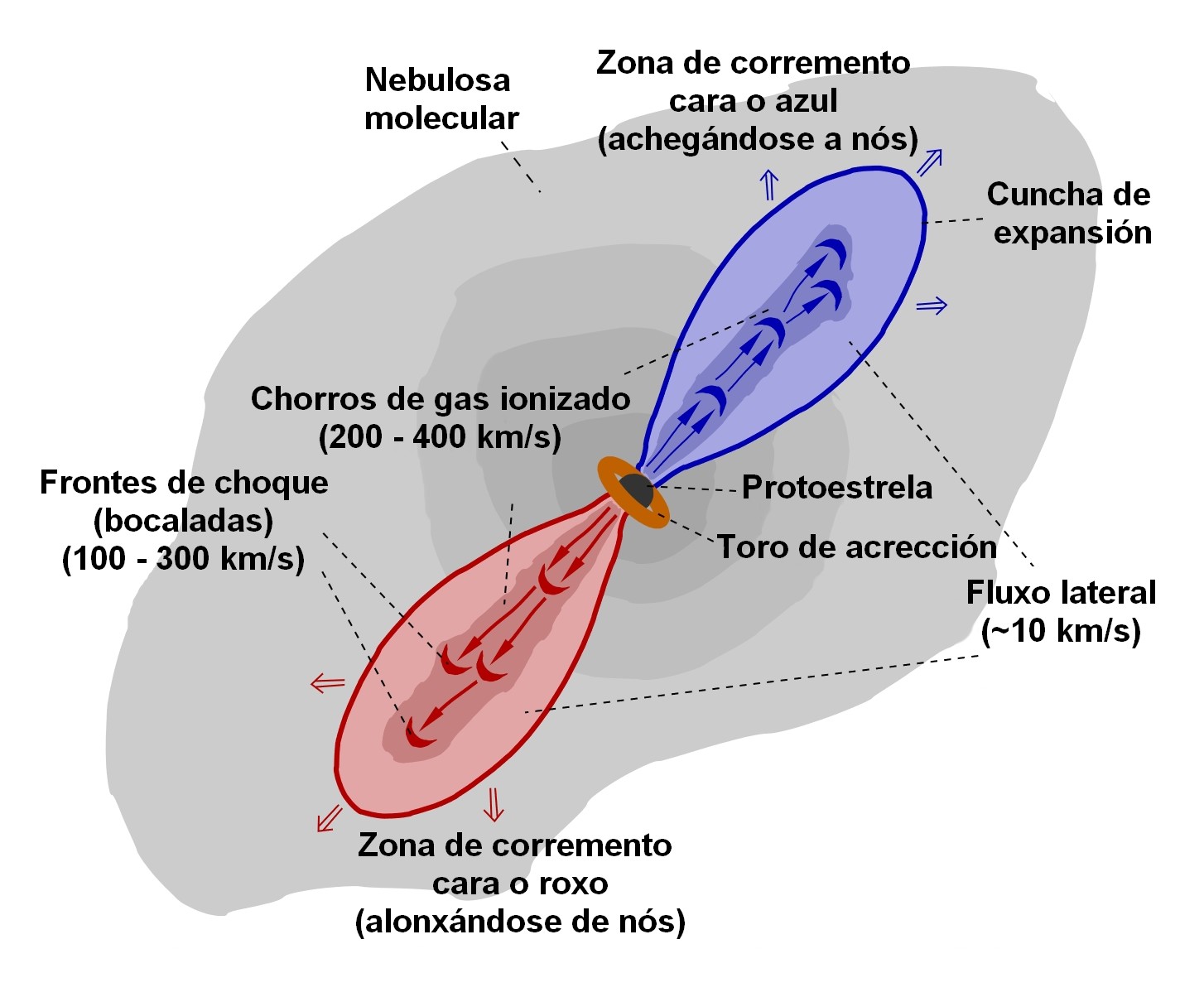Obxecto estelar HH-111

Créditos: Hubble (ESA-NASA)
(Pulsar foto para ampliar / Press photo to expand)
(Pulsar sobre texto para cambiar de idioma)
(Press on text to change language)
Na fotografía inferior -recentemente sacada polo Hubble- vemos un deses estraños obxectos que existen na nosa galaxia. O conxunto impresiona tanto polo colorido como polo aspecto. Chámanse sistemas Herbig-Haro e consisten en estrelas moi novas que naceron moi xuntas dentro dunha das moitas nubes de gas e po que se atopan nas inmediacións do Cinto de Orión (na constelación do Arqueiro, en concreto a nube L1617). Parece que hai dúas estrelas que danzan moi cinguidas a velocidades vertixinosas e que están acompañadas de lonxe por outra. O seu nome é HH 111.
O sistema atópase a 1.360 años luz de nós e crese que o chorro se formou hai tan só 800 anos. Ten unha lonxitude de 12 anos-luz por ambos polos, tanto como tres veces a distancia dende o Sol ata alfa-Centauro, a estrela que nos queda máis próxima.
Non se percibe ben, pero por detrás do chorro principal hai outro máis pequeno e roxiño, o HH-121. A xuízo dos astrónomos, ambos saen dun remuíño causado pola combinación resultante dunha intensa atracción gravitatoria entre as estrelas que, por outra banda están moi quentes e xirando coma tolas nun campo magnético intenso.

As novas estrelas adoitan ser moi activas e, nalgúns casos, expulsan chorros moi estreitos de gas ionizado en movemento rápido, un gas tan quente que as súas moléculas e átomos perden electróns. Isto fai que se cargue e brille intensamente. A brillante fumeira aparenta ter unhas zonas máis densas ca outras, coma bocaladas. Se se comparan fotos tomadas cunha separación de tempo suficiente, calcúlase que se despraza a uns 300 km por segundo, no inicio e despois fréase. Parece ser que este gas recibe impulso lineal do sistema estelar sen intervir o campo magnético da estrela que aporta o material, cousa que parece contradicir algunhas teorías amplamente recoñecidas.
As distintas cores da imaxe obtéñense mediante filtros que se colocan diante das lentes do telescopio. Despois combínanse por ordenador para extraer información sobre a composición do obxecto. Mediante esta técnica, os investigadores saben que as zonas máis avermelladas correspóndense con hidróxeno molecular ionizado (que brilla fóra do espectro visible pero que perciben perfectamente os sensores fotográficos), as azuis son de amoníaco tal vez mesturado con nitróxeno e xofre, e as pardas e amarelas son principalmente de carbono e de moléculas simples que conteñen este elemento. As correntes brillan aínda máis cando chocan contra o gas que circunda á nebulosa.
As estrelas implicadas neste singular fenómeno están rodeadas dun disco toroidal de material que absorbe unha gran parte da radiación que emiten, polo que non se deixan ver con claridade. Para evitar este inconveniente, a nova imaxe de HH-111 obtívose a partir de exposicións separadas que foron tomadas na rexión infravermella do espectro coa cámara amplo campo 3 (WFC3) do Hubble.

Na imaxe precedente, dous obxectos Herbig-Haro na rica nebulosa de Carina (ou da Quilla), outra zona de abundante formación estelar.





